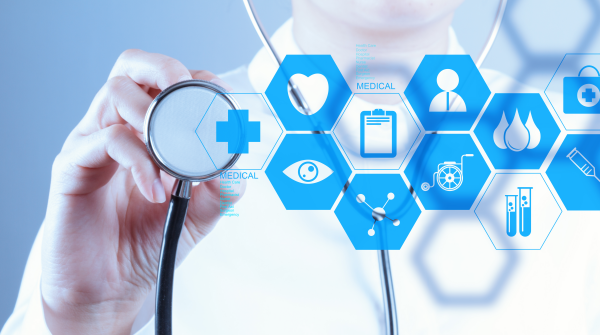How 5G can help IoT in healthcare

How 5G can help IoT in healthcare

At a time when the demand for healthcare services is steadily rising, resources are limited and costs need to be kept at a minimum. IoT promises to be a panacea for healthcare, increasing its reach, efficiency, interoperability, accuracy and value.
IoT has the potential to revolutionize the healthcare industry, reshaping the way people and devices interact to provide fast and reliable healthcare solutions. From wirelessly connected wearable and implantable devices, such as fitness bands, blood pressure and heart rate monitors, blood glucose meters, to remote monitoring, and even surgical guidance for remote patients, the Internet of Things makes many of them a reality.
The medical electronics market has grown exponentially over the past few years and is expected to reach 6.90% by 2030. However, it’s important to note that none of this would be possible without the power of connectivity.
All of these advancements depend on network connectivity and speed. Nonstop connectivity forms the backbone of IoT in healthcare, and 5G is the panacea for this pillar.
Once fully implemented, the fifth generation of telecommunications will be the biggest change in mobile technology, surpassing any previous generation. Its envisioned promise of speed, capacity, reduced power consumption and zero latency will enable a range of innovative new products and services.
Early tests suggest that 5G networks will be up to 100 times faster than current mobile technology. For the healthcare sector in particular, 5G has the potential to be a boon as it can connect entire networks of devices with its smaller, more densely deployed antennas. With bandwidth measured in gigabits, IoT will finally be able to deploy its truly disruptive applications.
IoT products today are often forced to be simple, sometimes bordering on gimmicky. But the fully connected home of the future holds the promise of using monitoring sensors and ancillary devices for everything from mobility to medication to make people live healthier and more comfortably at home.
Symbiotic robots, 3D printed prosthetics, mood monitors and telehealth services will all be included in the smart home of the future. But 5G's speed, reliability, energy efficiency and low latency will allow them to operate seamlessly. Here are some of the benefits that 5G-powered IoT could bring to the healthcare industry:
1. Increased use of wearables
As the demand for health wearable devices increases, there is a need to connect these devices to cloud-based software. This cloud architecture supports real-time collection, analysis and transmission of health data. These wearable devices are designed to improve monitoring of patients, covering everything from basic health conditions to chronic health conditions.
Demand for implants, from pacemakers to neurostimulators and infusion pumps, has also been increasing in recent years, especially in elderly patients. All of these devices work smoothly when connected to always-on smartphones and hospital trackers to alert frontline responders in the event of any emergency.
2. Better telemedicine
5G has the potential to open up new frontiers for telemedicine and remote patient monitoring, enabling telemedicine at scale through the promised speed, increased reliability and security. These improvements will allow patients in isolation or living in remote areas to receive unrestricted monitoring by healthcare providers. With 5G transmission speed approaching 15 to 20Gbps, this will ensure better real-time video or live chat. This will also potentially reduce outpatient visits, thereby reducing queues and lowering chances of infection.
3. 24/7 monitoring and faster diagnosis
The Internet of Things supported by 5G networks will allow 24-hour monitoring of patients. This will help alert healthcare workers to impending events, including low blood sugar, increased heart attack risk or other vital signs that may require closer intervention. Continuous monitoring will help deliver the right insights, faster and more accurate diagnoses, enabling a more personalized response.
4. Easier and faster data transfer
A single patient's medical records can be hundreds of gigabytes in size, and transferring those files to different locations can seem like a huge challenge. With instant transmission, 5G capacity promises to eliminate the congestion typically faced in the medical field. Additionally, as more and more devices connect across the spectrum, large data files will move quickly, ensuring patients receive the best advice in a timely manner.
5. Infrastructure improvement
Healthcare has been accused of delaying responses time and time again. With a well-connected IoT, critical infrastructure improvements can be achieved. An ambulance connected to the cloud network can respond immediately to a health emergency in the area, sending a first-level report to the hospital even before the patient reaches the location.
From the above discussion it is clear that in addition to smart homes and smart cities, the speed, capacity and reliability of 5G networks will drive new innovations in healthcare in incredible ways. While predictions about 5G's potential in healthcare are boundless, as with many new technologies, there are challenges in its development, particularly how regulators and policymakers will respond to the opportunities and challenges.
However, it is critical that we accelerate our preparations for 5G so that, as a race, we are better prepared for any unprecedented event. Recent outbreaks have shown us how sensitive we are to health emergencies, and in technologies such as the Internet of Things, we may have an antidote.
Healthcare systems around the world are investing heavily in research and development, and the Internet of Things may take us to the next level in this fight. What remains to be seen is how the healthcare sector seizes this opportunity and makes healthcare accessible to all.